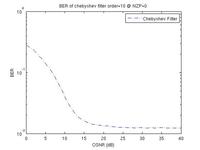Heidi.Eissa
Newbie level 4
I'm designing an analog chebyshev filter of order =10 and i want to know the formula of group delay , i know it's -1*derivative of phase of frequency response but i wonder if there is a clearer formula for the chebyshev filter relating the group delay with the filter order .. if you know i'd be very thankful for your help !
thank !
thank !
